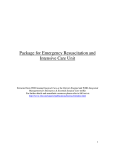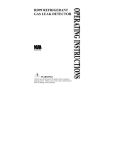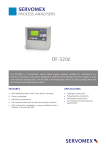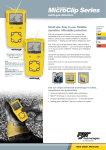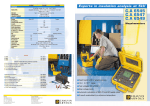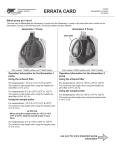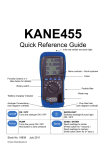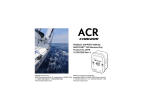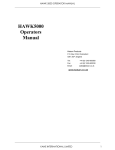Download FAQs - Keison Products
Transcript
Frequently Asked Questions About Automatic External Defibrillators (AEDs) What is an AED? AED stands for "Automatic External Defibrillator." An AED is used to administer an electric shock to a person who is having a cardiac arrest. AEDs are designed to allow non-medical personnel to save lives. How does an AED work? Two pads, which are connected to the AED, are placed on the patient's chest. A computer inside the AED analyzes the patient's heart rhythm and determines if a shock is required to save the victim. If a shock is required, the AED uses voice instructions to guide the user through saving the victims life. The need for an AED Why do we need AEDs? AEDs save lives. When a person has a sudden cardiac arrest (SCA), their heart's regular rhythm becomes chaotic or arrhythmic, which means it is not pumping blood around the body. Every minute that the heart is not beating lowers the odds of survival by 7% to 10%. After 10 minutes without defibrillation very few people survive. Information on Sudden Cardiac Arrests (SCA) What is Sudden Cardiac Arrest? Sudden cardiac arrest is when the heart's normal rhythm suddenly becomes chaotic. The heart can no longer pump the blood effectively and the victim collapses, stops breathing, becomes unresponsive, and has no detectable pulse. When used on a victim of SCA, the AED can be used to administer a life-saving electric shock that restores the heart's rhythm to normal. Is SCA the same as a heart attack? Both a heart attack (myocardial infarction) and a sudden cardiac arrest have to do with the heart, but they are different problems. SCA is an electrical problem; a heart attack is a "plumbing" problem. Sometimes a heart attack, which may not be fatal in itself, can trigger a sudden cardiac arrest. Who can have a SCA? Anyone at anytime: Children, teenagers, athletes and old people can have SCAs. Although the risk of SCA increases with age and in people with heart problems, a large percentage of the victims are people with no known risk factors. The Treatment for SCA What is the recommended treatment for SCA? Defibrillation is the only treatment proven to restore a normal heart rhythm. How much time do I have to respond if someone has a sudden cardiac arrest? You only have minutes to respond. Defibrillation within 3 minutes means the chances of survival are 70%. After 10 minutes, the chances of survival are negligible. I know CPR; wouldn't it help? CPR is an essential part of resuscitation but it only buys a little more time – potentially giving the victim a small amount of extra time until a defibrillator arrives. But SCA ultimately requires a shock to restore a normal heart rhythm. As a result, most CPR training now also includes AED training. Ease of Use Is an AED complicated to use? AEDs are designed to be very easy to use. An AED can be used by practically anyone who has been shown what to do. In fact, there are a number of cases where people with no training at all have saved lives. Can a non-medical person make a mistake when using an AED? AEDs are safe to use by anyone who has been shown how to use them. The AEDs voice guides the rescuer through the steps involved in saving someone; for example, "apply pads to patient's bare chest" (the pads themselves have pictures of where they should be placed) and "press red shock button". Furthermore, safeguards have been designed into the unit precisely so that non-medical responders can't use the AED to shock someone who doesn't .need a shock. Can the AED itself make a mistake? It is unlikely. Studies show that AEDs interpret the victim's heart rhythm more quickly and accurately than many trained emergency professionals. If the AED determines that no shock is needed, it will not allow a shock to be given. Has anyone been revived by using this AED? Even though our AED has only been on the market since 2003, it has already saved a number of people's lives. Maintenance How often must I change the battery? Our AED comes with a lithium battery pack that is available in a 5 or 7-year size. If the unit is used frequently, the battery pack may have to be replaced more often. The AED will inform the user when the battery pack needs to be replaced. What else do I need to do to keep my AED in working order? The pad package must be replaced every two years. Otherwise, the AED performs automatic self-checks on a regular basis to test its operational readiness. If anything is not fully functional, the unit will make a loud chirp and flash a red light warning the owner that servicing may be required. Buying an AED Can anyone buy an AED? Yes, anyone can buy an AED. What features should I look for in an AED? Firstly, an AED that is easy for non-medical people to use. Secondly, an AED that is technically reliable. Thirdly, one that is reasonably priced. Our AED more than meets all three requirements. Why is the Lifeline AED better than other AEDs? Our AED was designed from the ground up, building on a foundation of previous AED-related knowledge and incorporating a number of design and technological innovations. As a result, the AED is a state-of-the-art defibrillator designed for the non-medical person. Advanced design techniques and robotic assembly allow us to sell the AED at the lowest price in the market. What is your warranty? The AED warranty is 5 years and the battery warranty is 3 years. Is it safe to use the AED when also using Oxygen on a patient? The warning in the Defibtech user's manual reads: “Danger! Possible explosion hazard if used in the presence of flammable anesthetics or concentrated oxygen”. This typically means that if the patient and AED were in an enriched oxygen environment, such as is found in a hyperbaric oxygen chamber, which might be used to treat decompression illness or to treat wound healing problems, then the shock should NOT be administered until the oxygen concentration is brought to a normal atmospheric level. During sudden cardiac arrest, the patient frequently receives supplemental oxygen if it is available and if it can be safely administered. There is no problem using the AED while the patient is receiving supplemental oxygen through a respiratory system regardless of if it is through a mask, nasal cannula, or endotrachael tube. Thank you for reading this data sheet. For pricing or for further information, please contact us at our UK Office, using the details below. UK Office Keison Products, P.O. Box 2124, Chelmsford, Essex, CM1 3UP, England. Tel: +44 (0)1245 600560 Fax: +44 (0)1245 808399 Email: [email protected] Please note - Product designs and specifications are subject to change without notice. The user is responsible for determining the suitability of this product.






